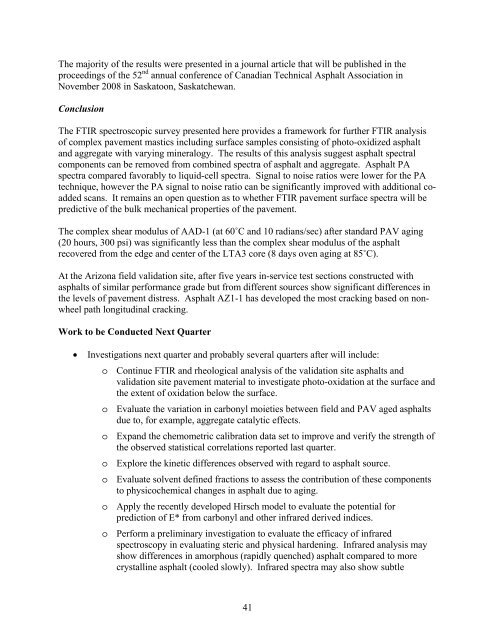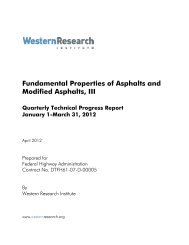Fundamental Properties of Asphalts and Modified Asphalts, III
Fundamental Properties of Asphalts and Modified Asphalts, III
Fundamental Properties of Asphalts and Modified Asphalts, III
You also want an ePaper? Increase the reach of your titles
YUMPU automatically turns print PDFs into web optimized ePapers that Google loves.
The majority <strong>of</strong> the results were presented in a journal article that will be published in the<br />
proceedings <strong>of</strong> the 52 nd annual conference <strong>of</strong> Canadian Technical Asphalt Association in<br />
November 2008 in Saskatoon, Saskatchewan.<br />
Conclusion<br />
The FTIR spectroscopic survey presented here provides a framework for further FTIR analysis<br />
<strong>of</strong> complex pavement mastics including surface samples consisting <strong>of</strong> photo-oxidized asphalt<br />
<strong>and</strong> aggregate with varying mineralogy. The results <strong>of</strong> this analysis suggest asphalt spectral<br />
components can be removed from combined spectra <strong>of</strong> asphalt <strong>and</strong> aggregate. Asphalt PA<br />
spectra compared favorably to liquid-cell spectra. Signal to noise ratios were lower for the PA<br />
technique, however the PA signal to noise ratio can be significantly improved with additional coadded<br />
scans. It remains an open question as to whether FTIR pavement surface spectra will be<br />
predictive <strong>of</strong> the bulk mechanical properties <strong>of</strong> the pavement.<br />
The complex shear modulus <strong>of</strong> AAD-1 (at 60˚C <strong>and</strong> 10 radians/sec) after st<strong>and</strong>ard PAV aging<br />
(20 hours, 300 psi) was significantly less than the complex shear modulus <strong>of</strong> the asphalt<br />
recovered from the edge <strong>and</strong> center <strong>of</strong> the LTA3 core (8 days oven aging at 85˚C).<br />
At the Arizona field validation site, after five years in-service test sections constructed with<br />
asphalts <strong>of</strong> similar performance grade but from different sources show significant differences in<br />
the levels <strong>of</strong> pavement distress. Asphalt AZ1-1 has developed the most cracking based on nonwheel<br />
path longitudinal cracking.<br />
Work to be Conducted Next Quarter<br />
• Investigations next quarter <strong>and</strong> probably several quarters after will include:<br />
o Continue FTIR <strong>and</strong> rheological analysis <strong>of</strong> the validation site asphalts <strong>and</strong><br />
validation site pavement material to investigate photo-oxidation at the surface <strong>and</strong><br />
the extent <strong>of</strong> oxidation below the surface.<br />
o Evaluate the variation in carbonyl moieties between field <strong>and</strong> PAV aged asphalts<br />
due to, for example, aggregate catalytic effects.<br />
o Exp<strong>and</strong> the chemometric calibration data set to improve <strong>and</strong> verify the strength <strong>of</strong><br />
the observed statistical correlations reported last quarter.<br />
o Explore the kinetic differences observed with regard to asphalt source.<br />
o Evaluate solvent defined fractions to assess the contribution <strong>of</strong> these components<br />
to physicochemical changes in asphalt due to aging.<br />
o Apply the recently developed Hirsch model to evaluate the potential for<br />
prediction <strong>of</strong> E* from carbonyl <strong>and</strong> other infrared derived indices.<br />
o Perform a preliminary investigation to evaluate the efficacy <strong>of</strong> infrared<br />
spectroscopy in evaluating steric <strong>and</strong> physical hardening. Infrared analysis may<br />
show differences in amorphous (rapidly quenched) asphalt compared to more<br />
crystalline asphalt (cooled slowly). Infrared spectra may also show subtle<br />
41





